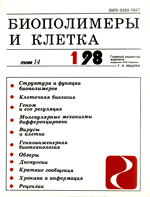The differentiation of the composition of light-soluble proteins of strawberry calluses with difference morphogenic potential
DOI:
https://doi.org/10.7124/bc.0004BCAbstract
A search for typical biochemical features of morphogenesis and its protein-marker has been performed by the composition of light-soluble proteins in morphogenic and non-morphogenic types of strawberry calluses. The protein composition differs significantly in morphogenic and non-morphogenic callus. The amount of proteins in the morphogenic callus is 1,4–1,6 times higher than non-morphogenic one. A great number of proteins zones specific for each callus type, has been revealed.References
Murashige T, Skoog F. A revised medium for rapid growth and bio assays with tobacco tissue cultures. Physiol Plant. 1962;15(3):473–97.
Yablokova EV, Kiyamova RG, Tuleneva NM, Kolesnichenko EV, Gorshkova TA, Zheltonozhskaya LV. Composition of cellular walls in callus cultures of strawberries with different capacity to morphogenesis. Biopolym Cell. 1996; 12(2):56-61.
Lowry OH, Rosebrough NJ, Farr AL, Randall RJ. Protein measurement with the Folin phenol reagent. J Biol Chem. 1951;193(1):265-75.
Laemmli UK. Cleavage of structural proteins during the assembly of the head of bacteriophage T4. Nature. 1970;227(5259):680-5.
Downloads
Published
1998-01-20
Issue
Section
Molecular Mechanisms of Differentiation

